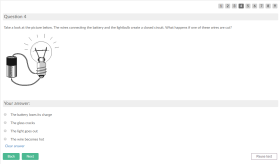Questions and alternatives
Multiple choice questions consist of two parts: A question and a given number of alternatives. You can use text, pictures, video and flash in both questions and alternatives. To add multiple choice questions, enter a test and click the Questions tab. Click Add, and select Multiple choice from the drop-down list.
Traditionally it has been common to use three alternatives in multiple choice questions, but it may be a good idea to use more alternatives. Four alternatives are considered by many to be the optimal number of alternatives.
Creating good distracters
In order to create a good multiple choice test, it is also important to create good distracters (the alternatives that are incorrect). If the distracters are poor, participants have few problems selecting the correct answer. Take a look at the example below:
Example 1: Multiple choice question
Question: Which of the following is not a chemical element?
Alternative 1: Lead
Alternative 2: Tin
Alternative 3: Bronze
Alternative 4: Gold
In this example, "bronze" is the correct answer.
To answer this question you actually have to know that bronze is an alloy and not a chemical element. You cannot easily eliminate, as all the alternatives are metals. Now, take a look at a similar question, now with other alternatives:
Example 2: Multiple choice question
Question: Which of the following is a metallic alloy?
Alternative 1: Plastic
Alternative 2: Nitric acid
Alternative 3: Bronze
Alternative 4: Wood
In this example, "bronze" is the correct answer.
Here it is fairly easy to deduce that "bronze" is the correct alternative.
 A multiple choice question consists of two parts: The question and the answer options. Participants read the questions, and answer by checking a box next to the correct answer. Note: If you want to allow more than one answer to be selected, use the Multiple response question type.
A multiple choice question consists of two parts: The question and the answer options. Participants read the questions, and answer by checking a box next to the correct answer. Note: If you want to allow more than one answer to be selected, use the Multiple response question type.  Uses
Uses Preview. By clicking the preview link, you can see the question from the participants' perspective. Submit an answer to see how the feedback looks for a correct and incorrect answer. Click the
Preview. By clicking the preview link, you can see the question from the participants' perspective. Submit an answer to see how the feedback looks for a correct and incorrect answer. Click the  Back link to continue editing the question.
Back link to continue editing the question.